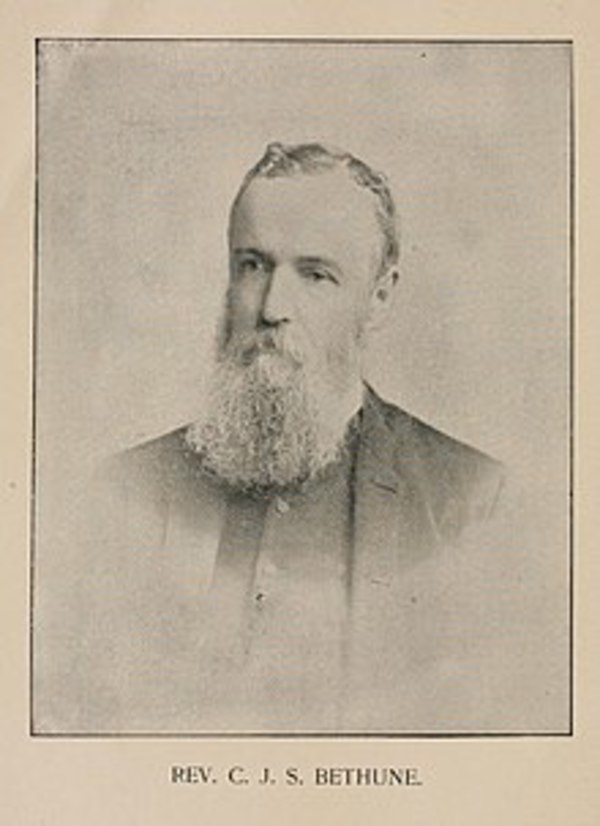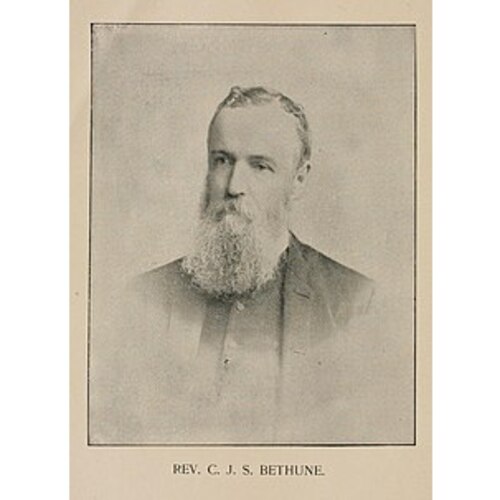
Source: Courtesy of Wikimedia Commons
BETHUNE, CHARLES JAMES STEWART, Church of England minister, educator, and entomologist; b. 11 Aug. 1838 in West Flamborough Township, Upper Canada, third son of Alexander Neil Bethune* and Jane Eliza Crooks; nephew of John* (1791–1872), James Gray*, Angus*, and Donald Bethune*; cousin of Norman Bethune*; grandson of John Bethune* (1751–1815) and James Crooks*; great-uncle of Henry Norman Bethune; m. 21 April 1863 Harriett (Harriet) Alice Mary Forlong (1844–98) in Toronto, and they had two sons and four daughters; d. 18 April 1932 in Toronto and was buried in Cobourg, Ont.
Born into a prominent family of Scottish heritage, Charles Bethune was educated at Upper Canada College in Toronto. He then attended Trinity College there, obtaining a ba in 1859 (with first-class honours in classics and distinction in mathematics) and an ma three years later; he would be awarded an honorary dcl in 1883. Ordained deacon in the Church of England in 1861, he became a priest the following year; Bishop John Strachan* presided on both occasions. His first appointment was as curate at St Peter’s Church in Cobourg, where his father, Alexander Neil, was rector. During his tenure there, Charles married Alice Forlong, daughter of Lieutenant-Colonel James Forlong of the 43rd Foot. Except for a brief period in 1863–64, when he was in England serving as curate in the village of Carlton, near Selby, Yorkshire (North Yorkshire), Bethune remained in Cobourg until 1866. He next took up what would be his only position as a parish priest, at the Credit Mission (Mississauga) in Peel County, and over the next few years he supervised the construction of churches in Dixie (Mississauga) and Port Credit (Mississauga). Though he would later move into the areas of education and science, Bethune played an active role in his church throughout his life. He was a delegate for many years to its diocesan and provincial synods, and he served as honorary clerical secretary of both the synod of the diocese of Toronto (1869–71) and the General Synod of the Church of England in Canada (1902–8).
In 1870, after initially refusing, Bethune was persuaded by his father to accept the position of headmaster at Trinity College School, which had been founded in Weston (Toronto) by William Arthur Johnson* in 1865 and had moved to Port Hope in 1868. Bethune remained there for 29 years, during which time the institution, which lacked an endowment or even a finished building when he arrived, developed into one of the most prestigious educational establishments for boys in Canada. This journey was not, however, a smooth one. Severe economic depressions occurred in the late 1870s and late 1880s, and four fires broke out over a four-year period, the last of which, in 1895, almost completely destroyed Trinity’s buildings. In 1890, overwhelmed by his increasing workload, Bethune asked the governing board for relief from some of his duties. For three years he served as warden while the Reverend Arthur Lloyd acted as headmaster, but in 1893, following Lloyd’s resignation, Bethune resumed his former position. After six more stressful years in charge, and following Alice’s death caused by injuries she suffered in an accident when the horses drawing her cab bolted, Bethune resigned and moved southwest to London, where he lived until 1906.
Few records relating to Bethune’s years in London seem to have survived, but it is clear that during this time he devoted much of his attention to entomology. He had been interested in the subject since childhood, and as an undergraduate at Trinity College in the 1850s he began to collect and study insects in earnest. Chemistry professor Henry Holmes Croft*, himself an amateur entomologist, put Bethune in contact with William Saunders*, a druggist in London and a fellow insect collector and naturalist. As their friendship developed, Bethune and Saunders decided to compile and publish a list of entomologists to facilitate interaction among like-minded individuals. Their efforts, carried out with Croft’s assistance, led to the formation of the Entomological Society of Canada on 16 April 1863. Bethune was appointed secretary-treasurer in 1864 and became president in 1871, the same year that the organization was renamed the Entomological Society of Ontario. A three-time head of the ESO (1871–75, 1890–92, and 1912–13), he also served as vice-president, council member, librarian, and curator of the insect collection. He was editor of the society’s publication, the Canadian Entomologist, from 1868 to 1873 and from 1886 to 1909, and was named editor emeritus after giving up his duties because of failing eyesight.
In the late 19th century the value of entomology to North American agriculture was becoming recognized, and Bethune came to be regarded as one of the best economic entomologists in Canada by his contemporaries, who included James Fletcher*, Charles Gordon Hewitt*, and Norman Criddle. In 1870, at the request of the provincial Bureau of Agriculture and Arts (a predecessor of the Department of Agriculture, which would be established in 1888), he helped prepare the first Annual report on the noxious insects of the province of Ontario. He would contribute to each annual report for the next three decades. For this continuing work the society received an annual grant of $400, which was increased to $1,000 after the bureau commissioned a special study of the Colorado potato beetle. “What really made the fortunes of the Society,” Bethune would reflect in his presidential address of 1913, “was the invasion of Ontario by the Colorado Potato Beetle.”
On 1 June 1906 Bethune, now 67 years of age, became professor and head of the department of entomology and zoology at the Ontario Agricultural College in Guelph. He held this position until his retirement in October 1920, and during his 14-year tenure he built the department into a strong teaching and research unit, with many of his students becoming well known in their fields. Bethune published regularly, and his most notable works include Insects affecting vegetables and Common insects affecting fruit-trees, as well as Insects of the northern parts of British America. The latter is a pared-down, annotated version of a volume written by William Kirby as part four (The insects, London, 1837) of the rare work Fauna Boreali-Americana, edited by John Richardson*. In addition, Bethune prepared the annual Bibliography of Canadian entomology, served as entomological editor of two Toronto journals, the Canada Farmer and Weekly Globe, and was a founding member of the American Association of Economic Entomologists. His great influence in the field was recognized with elections to the Royal Society of Canada, the American Association for the Advancement of Science, and the Entomological Society of America (which he headed in 1913); he was also made a corresponding member of other scientific societies in Canada, the United States, and England.
Throughout his career as a man of science, Bethune remained a devoutly religious person. In his daily life he was comfortable in the company of amateurs and professional entomologists alike when dealing with economic entomology and the collection, identification, and classification of specimens, but he was a firm believer in God the Creator and steadfastly avoided discussing the ideas espoused by Charles Darwin and others regarding the origin and evolution of species. In an editorial for the Canadian Entomologist in 1871, Bethune revealed something of his views when he invited fellow insect lovers to “help us to trace out the wondrous beauties of structure, form and coloring of these marvels of the Creator’s power.” Years later, when a student asked him why God had created butterflies, Bethune replied simply, “Because the Lord has an eye on the beautiful.”
When Charles Bethune died suddenly at the age of 93 in Toronto, the Canadian Entomologist observed that “he had retained unimpaired throughout the years that keen mind which was the delight of all who knew him,” and reflected that “to him entomology in Canada owes much. His passing severs a tie with the beginning of the science in this country.” An earnest, kindly man with a long white beard (which inspired students to nickname him “the Goat” during his years as headmaster of Trinity), Bethune was remarkable not only for his contributions to the early history of North American entomology, but also for achieving success in the fields of religion and education during what the Canadian Entomologist referred to as his “long but very busy and useful life.” Bethune House, a residence for male boarding students at Trinity College School, is named in his honour.
Charles James Stewart Bethune was the editor of the Canadian Entomologist (London, Ont., etc.) in 1868–73 and 1886–1909, and he compiled the Bibliography of Canadian entomology … (Ottawa) for many years. He was also entomological editor of the Canada Farmer and the Weekly Globe, published in Toronto, and contributed to the Annual report on the noxious insects of the province of Ontario … (Toronto) for three decades, beginning in 1871. The author of Common insects affecting fruit-trees (Toronto, 1907) and Insects affecting vegetables (Toronto, 1909), he published “Insects of the northern parts of British America,” both serially in the Canadian Entomologist, 2–13 (1870–81), and as a monograph (n.p., [1876?]). His 1913 presidential address to the Entomological Soc. of Ont. is described in the Canadian Entomologist, 45 (1913): 353–56.
LAC, R233-34-0, Ont., dist. Durham East (51), subdist. Port Hope (B), div. 3: 14; R233-35-2, Ont., dist. Durham East (127), subdist. Hope (A), div. 1: 5; R233-36-4, Ont., dist. Durham East (58), subdist. Hope (B), div. 1: 42. A. W. Baker, “A short history of the Entomological Society of Ontario,” Canadian Entomologist, 71 (1939): 14–20. Canadian biographical dictionary and portrait gallery of eminent and self-made men (2v., Toronto, 1880–81), Ont. vol. Canadian men and women of the time (Morgan; 1912). “Charles James Stewart Bethune, m.a., d.c.l.,” Canadian Entomologist, 64 (1932): 97–98. Cyclopædia of Canadian biog. (Rose and Charlesworth), vol.3. A. H. Humble, with the collaboration of J. D. Burns, The school on the hill: Trinity College School, 1865–1965 (Port Hope, Ont., 1965). Arnold Mallis, American entomologists (New Brunswick, N.J., 1971). “Our third volume,” Canadian Entomologist, 3 (1871): 1–2. Paolo Palladino, Entomology, ecology and agriculture: the making of scientific careers in North America, 1885–1985 (Amsterdam, 1996). “The Rev. Charles James Stewart Bethune, m.a., d.c.l., f.r.s.c., born 1838, died 1932,” Trinity College School Record (Port Hope), 35 (December 1931–July 1933), no.3: 3–5. John Richardson et al., Fauna Boreali-Americana … (4 pts., London, 1829–37), 4 (William Kirby, The insects, 1937). T. J. Spilman, “Vignettes of the presidents of the Entomological Society of America, 1889–1989,” Entomological Soc. of America, Bull. (Washington), 35 (1989), no.3: 33–65. Standard dict. of Canadian biog. (Roberts and Tunnell), vol.1.
Cite This Article
Cedric Gillott, “BETHUNE, CHARLES JAMES STEWART,” in Dictionary of Canadian Biography, vol. 16, University of Toronto/Université Laval, 2003–, accessed December 28, 2025, https://www.biographi.ca/en/bio/bethune_charles_james_stewart_16E.html.
The citation above shows the format for footnotes and endnotes according to the Chicago manual of style (16th edition). Information to be used in other citation formats:
| Permalink: | https://www.biographi.ca/en/bio/bethune_charles_james_stewart_16E.html |
| Author of Article: | Cedric Gillott |
| Title of Article: | BETHUNE, CHARLES JAMES STEWART |
| Publication Name: | Dictionary of Canadian Biography, vol. 16 |
| Publisher: | University of Toronto/Université Laval |
| Year of publication: | 2022 |
| Year of revision: | 2022 |
| Access Date: | December 28, 2025 |



